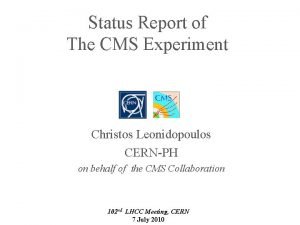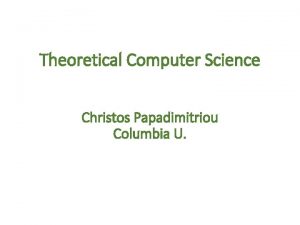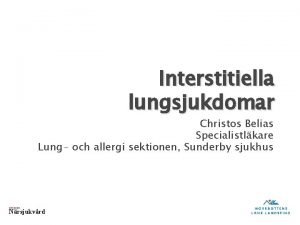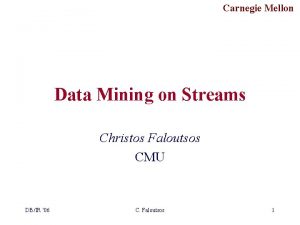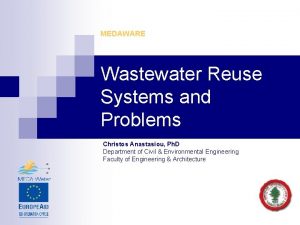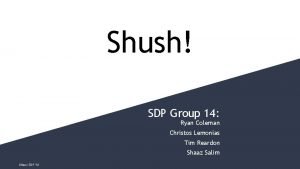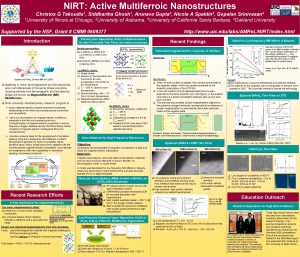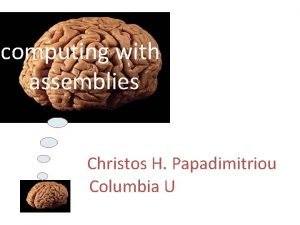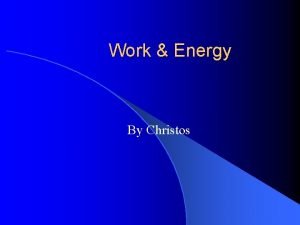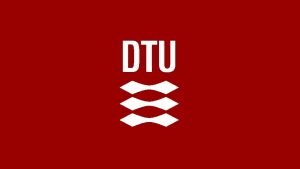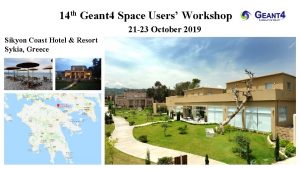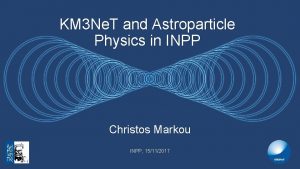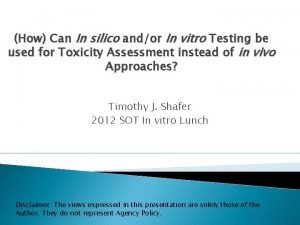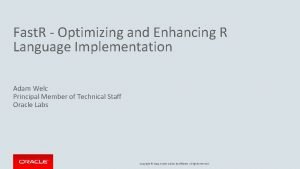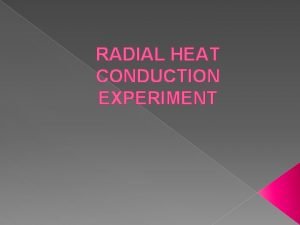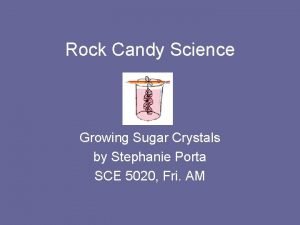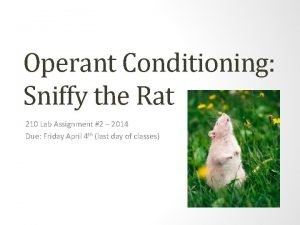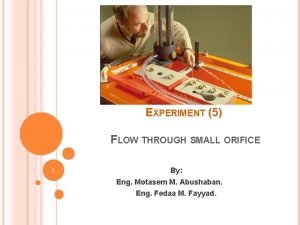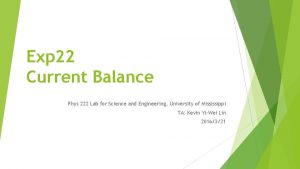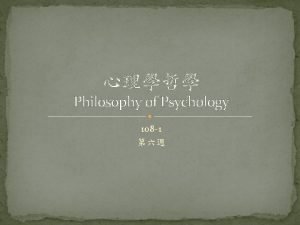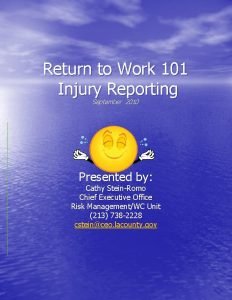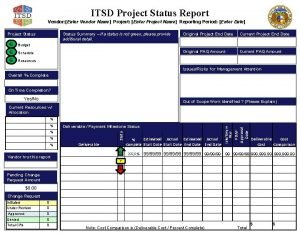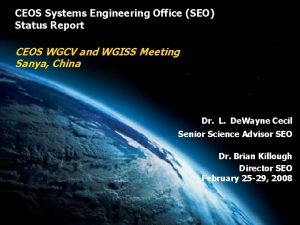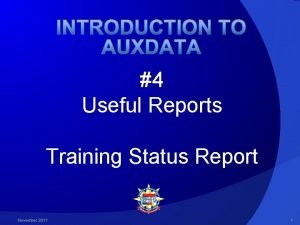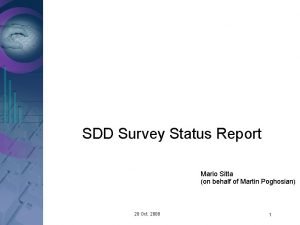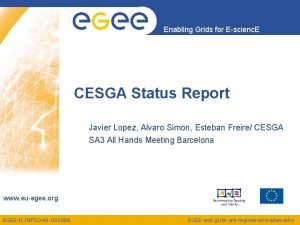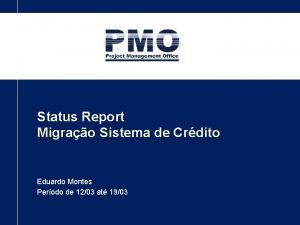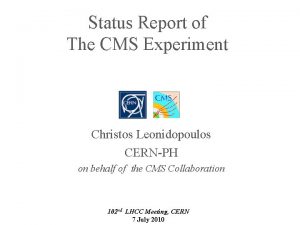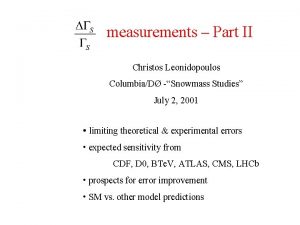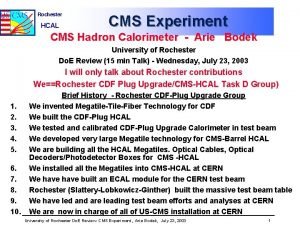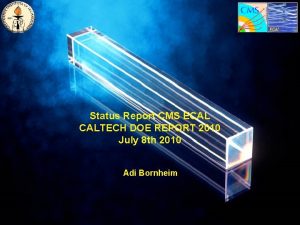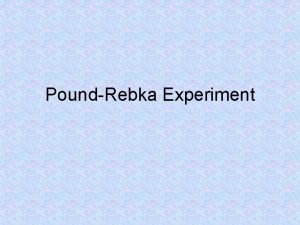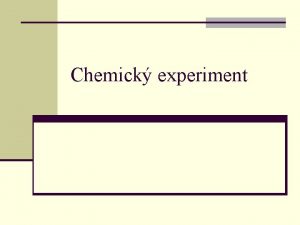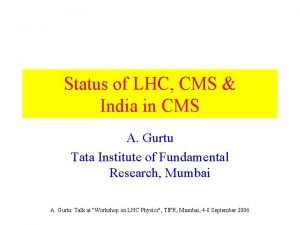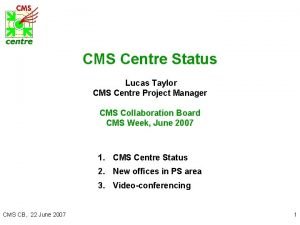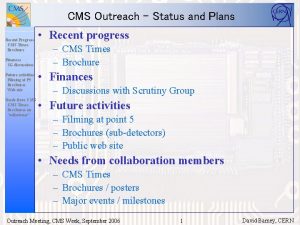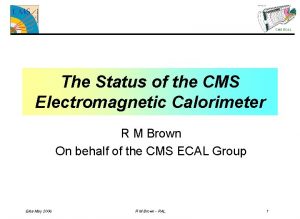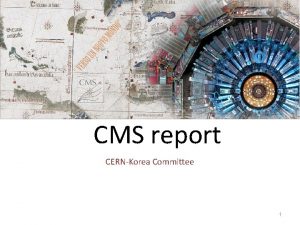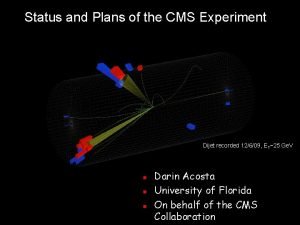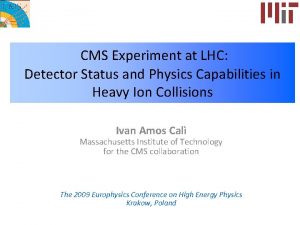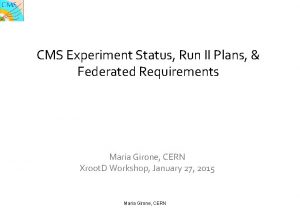Status Report of The CMS Experiment Christos Leonidopoulos







































































- Slides: 71

Status Report of The CMS Experiment Christos Leonidopoulos CERN-PH on behalf of the CMS Collaboration 102 nd LHCC Meeting, CERN 7 July 2010

The Collaboration AACHEN-1, AACHEN-3 A, AACHEN-3 B, ADANA-CUKUROVA, ANKARA-METU, ANTWERPEN, ATHENS, ATOMKI, AUCKLAND, BARI, BEIJING-IHEP, BOGAZICI, BOLOGNA, BOSTON-UNIV, BRISTOL, BROWN-UNIV, BRUNEL, BRUSSEL-VUB, BRUXELLES-ULB, BUDAPEST, CALTECH, CANTERBURY, CARNEGIE-MELLON, CATANIA, CCCSUWE, CERN, CHANDIGARH, CHEJU, ILLINOIS-CHICAGO, CHONNAM, CHUNGBUK, CHUNGLI-NCU, COLORADO, CORNELL, DEBRECEN-IEP, DELHI-UNIV, DEMOKRITOS, DESY, DONGSHIN, DUBLIN-UCD, DUBNA, EINDHOVEN, FAIRFIELD, FERMILAB, FIRENZE, FLORIDA-FIU, FLORIDA-STATE, FLORIDA-TECH, FLORIDA-UNIV, FRASCATI, GENOVA, GHENT, HAMBURG-UNIV, HEFEI-USTC, HELSINKI-HIP, HELSINKI-UNIV, HEPHY, IOANNINA, IOWA, IPM, ISLAMABAD-NCP, JOHNS-HOPKINS, KANGWON, KANSAS-STATE, KANSAS-UNIV, KARLSRUHE-IEKP, KHARKOVISC, KHARKOV-KIPT, KHARKOV-KSU, KONKUK-UNIV, KOREA-UNIV, KYUNGPOOK, LAPPEENRANTA-LUT, LIP, LIVERMORE, LONDON-IC, LOUVAIN, LYON, MADRID-CIEMAT, MADRID-UNIV, MARYLAND, MEXICOIBEROAM, MEXICO-IPN, MEXICO-PUEBLA, MEXICO-UASLP, MILANO-BICOCCA, MINNESOTA, MINSK-INP, MINSKNCPHEP, MINSK-RIAPP, MINSK-UNIV, MISSISSIPPI, MIT, MONS, MOSCOW-INR, MOSCOW-ITEP, MOSCOWLEBEDEV, MOSCOW-MSU, MOSCOW-RDIPE, MUMBAI-BARC, MYASISHCHEV, NAPOLI, NEBRASKA, NICOSIA-UNIV, NORTHEASTERN, NORTHWESTERN, NOTRE DAME, NUST, OHIO-STATE, OVIEDO, PADOVA, PAVIA, PEKING-UNIV, PERUGIA, PISA, POLYTECHNIQUE, PRINCETON, PROTVINO, PSI, PUERTO RICO, PURDUE-CALUMET, RAL, RICE, RIO-CBPF, RIO-UERJ, ROCHESTER, ROCKEFELLER, ROMA-1, RUTGERS, SACLAY, SANTANDER, SAO PAULO, SEONAM, SEOUL-EDU, SEOUL-SNU, SHANGHAI-IC, SKK-UNIV, SOFIA-CLMI, SOFIA-INRNE, SOFIAUNIV, SPLIT-FESB, SPLIT-UNIV, ST-PETERSBURG, STRASBOURG, SUNY-BUFFALO, TAIPEI-NTU, TALLINN, TASHKENT, TBILISI-IHEPI, TBILISI-IPAS, TENNESSEE, TEXAS-TAMU, TEXAS-TECH, TIFR-EHEP, TIFR-HECR, TORINO, TRIESTE, UCDAVIS, UCLA, UC RIVERSIDE, UC SANTA BARBARA, UC SAN DIEGO, UNIANDES, VANDERBILT, VILNIUS-ACADEMY, VILNIUS-UNIV, VINCA, VIRGINIA-TECH, VIRGINIA-UNIV, WARSAW-IEP, WARSAW-INS, WARSAW-ISE, WAYNE, WISCONSIN, WONKWANG, YEREVAN, ZAGREB-RUDJER, ZURICH-ETH, ZURICH-UNIV • 182 Institutions • 3000 scientists and engineers • 2000 Authors 2

Reminder: we went from this… 3. 8 T Superconducting Solenoid Lead tungstate E/M Calorimeter (ECAL) Hermetic (|η|<5. 2) Hadron Calorimeter (HCAL) [scintillators & brass] All Silicon Tracker (Pixels and Microstrips) Redundant Muon System (RPCs, Drift Tubes, Cathode Strip Chambers) 3

…to this First 7 Te. V collisions in CMS – 30 March 2010

…and this, just three months later

Life did not begin in a vacuum with the first collisions

One Billion Cosmic Muons before collisions 7

23 JINST papers: March 2010 (Vol. 5) Feedback into realistic simulation to help us prepare for collisions 8

Detector understanding • “Why should we believe that the simulation correctly describes the detector performance? ” • Excellent question! • Te. Vatron experience: it takes a long time to commission & understand collider experiments ØAccelerator, detector, trigger, background, underlying event, software: very complicated problems Claim: • Cosmic runs/beam tests have made a difference • First data distributions agree well with simulation 9

From data-taking to the plots CMS is still in the commissioning phase • Hard work, long hours • Despite early phase and complexity of experiment Ø Unprecedented levels of readiness Ø Very encouraging first results • But: Ø Always problems seeking solutions Ø Hardest part is ahead of us 10

Operations

Integrated luminosity L≈ 1030 cm-2 s-1 L≈ 1027 -1029 cm-2 s-1 7 h( T ): V e arc (*) ) f M red % o e (~88 d v n i e e -1 del ded c Sin nb ecor 0 r 10 nb-1 88 (*) Stable beams only • ~3/4 of data recorded arrived in last 10 days • Working hard to integrate full datasets for ICHEP • Most performance plots use only fraction of data 12

Subdetectors status PIXEL TRACKER STRIP TRACKER PRE-SHOWER ECAL END-CAP ECAL BARREL HCAL FORWARD HCAL ENDCAP HCAL BARREL MUON-RPC MUON-DT MUON-CSC 90 91 92 93 94 95 96 HCAL ECAL MUON- HCAL ECAL FORWA ENDCSC DT RPC BARREL ENDCAP BARREL RD CAP Series 1 98. 5 99. 8 98. 8 99. 9 100 99. 9 99. 3 98. 9 97 STRIP 98 PIXEL 99 PRESHOWE TRACKE R R R 99. 8 98. 1 98. 2 100 Alignment/calibration status, dead/masked channels mirrored in MC 13

“The Trigger does not determine which Physics Model is Right. Only which Physics Model is Left. ”

DAQ/Trigger • L 1/DAQ rate: 45 k. Hz, @<0. 5 MB/evt • High-Level Trigger: have successfully deployed online trigger menus spanning luminosities from 1 E 27 through 2 E 30 o Very smooth running throughout (200 -400 Hz) • HLT CPU-performance: 49 ms/evt o Primary contributors: commissioning and early analysis triggers Run 138737 o Contingency: factor of 2 Overflows taken into o Constantly on watch list account in the mean 15

Trigger Performance • HLT muon efficiency wrt L 1 • L 1 objects matched to offline objects • ~90% efficiency at the plateau • Photon efficiency wrt offline “super clusters” • For barrel & endcaps • Nearly 100% efficient 16

Predicting trigger rates: MC vs. data “Building trigger menus 101” 17

Predicting trigger rates: MC vs. data Monte Carlo: • Only used as a cross-check at this point • Some trigger paths have significant cosmic or noise distributions that are not modeled with “baseline” MC • Still, impressive agreement overall Using MC to cross-check 4. 6 E 29 rates 18

Predicting trigger rates: MC vs. data Data: • Most triggers exhibit fairly linear behavior vs. luminosity • Extrapolation errors minimized by using most recent data to keep the rate non-linearities under control • Rates of all main players are predicted within ~20% Using 1. 2 E 29 rates to predict 4. 6 E 29 rates 19

Calibration Trigger Streams • Calibration triggers have access to full L 1 rate, and they output small fraction of event • Feature unique to CMS HLT • Calibration starts online! 20

Trigger calibration streams • Calibration triggers have access to full L 1 rate, and they output small fraction of event • π0 peak reconstructed offline 200 seconds into 7 Te. V run 30 March 2010 21

LHC has delivered Trigger has accepted CMS will analyze 22

Analysis Activity Routinely delivering 100 k jobs per day October 09 MC Exercise 7 Te. V data Winter Break 10 -20 k analysis jobs running on Tier-2 s continuously every day of June 23

Physics production

3+1 CMS papers since May 25

CMS paper at 7 Te. V “Transverse Momentum and Pseudorapidity Distributions of Charged Hadrons in pp Collisions at √s=7 Te. V”, submitted to PRL • Rise of the particle density at (2. 36) 7 Te. V steeper than in models • Careful tuning effort of the MC generators is ongoing 26

Detector & Physics Performance Calorimetry Tracking Jets b-tagging Muon EWK/Onia Particle Flow Electron EWK/Onia

Detector & Physics Performance Calorimetry Tracking Jets b-tagging Muon EWK/Onia Particle Flow Electron EWK/Onia

Calorimetry: π0 and η → γγ MC based correction applied according to cluster η and energy 1. 46 M of π0 → γγ PT(γ) > 0. 4 Ge. V, PT(pair) > 1 Ge. V DATA MC 0. 43 nb-1 1. 46 M π0 25. 5 K η → γγ PT(γ) > 0. 5 Ge. V, PT(pair) > 2. 5 Ge. V DATA MC 0. 43 nb-1 25. 5 k η • Statistics refer to < 0. 5 nb-1 • Very useful tool to intercalibrate the crystals • Good agreement in width and Signal/Background ratio • Masses agree with expectations to within 1% 29

Calorimetry: Missing ET Calorimetric MET (Ge. V) Jets reconstructed with the anti-k. T R=0. 5 algorithm • Dijet selection : Jet PΤ > 25 Ge. V, Δφ > 2. 1, |η| < 3 • Loose ID cuts on number of components and neutral/charged energy fraction • 30

Detector & Physics Performance Calorimetry Tracking Jets b-tagging Muon EWK/Onia Particle Flow Electron EWK/Onia

Calorimetric di-jet events s t je Di s a m Δφ(j 1, j 2) # of Calo Towers Fraction of EM energy in Calo-Jets 32

Detector & Physics Performance Calorimetry Tracking Jets b-tagging Muon EWK/Onia Particle Flow Electron EWK/Onia

Tracking distributions

Muon distributions “Global Muons”: matched tracks from Muon system and Tracker Global Muons • η and p. T distributions dominated by light hadron decay muons (red) • good agreement with MC prediction, including o heavy flavor decays (blue) o punch-through (black) o fakes (green) 35

Tracking distributions η distribution φ distribution p. T spectrum 36

Tracker Material Budget η distribution φ distribution 37

Tracker Material Budget η distribution φ distribution pixel cluster charge 38

Tomography 39

Detector & Physics Performance Calorimetry Tracking Jets b-tagging Muon EWK/Onia Particle Flow Electron EWK/Onia

b-tagging 3 D IP significance 3 D impact parameter value and significance all tracks with p. T> 1 Ge. V belonging to jets with p. T > 40 Ge. V and |η| < 1. 5 - PFlow Jets anti-k. T R=0. 5) Excellent alignment and general tracking performance 41

b-tagging example Two b-jets candidate 42 42

CMS experiment at LHC, CERN Run 136100 / Event 256858438 2010 -25 -5 03: 48 CEDT B- → J/y. K- candidate

CMS experiment at LHC, CERN Run 136100 / Event 256858438 2010 -25 -5 03: 48 CEDT B- → J/y. K- candidate All other tracks: p. T > 1. 0 Ge. V/c

Detector & Physics Performance Calorimetry Tracking Jets b-tagging Muon EWK/Onia Particle Flow Electron EWK/Onia

Particle Flow • Particle Flow: Full Event reconstruction Ø Topological matching between charged particle momenta measured with tracker with clusters in calorimeter Ø Corrects for energy loss along trajectories Ø Better precision, full event info • High-level object: requires holistic detector view Ø Excellent tracker Ø High E/M calorimeter granularity (0. 017 × 0. 017) Ø Strong magnetic field to separate tracks • CMS very well suited for P-Flow reconstruction 46

Particle Flow MET 47

Particle Flow MET Laser forgotten on Need cleaning strategies developed based on timing constraints 48

Particle Flow MET Comparison between calorimetric and Particle-Flow MET (Minimum bias events) 49

Detector & Physics Performance Calorimetry Tracking Jets b-tagging Muon EWK/Onia Particle Flow Electron EWK/Onia

J/ψ → μ+μ− 56 nb-1 Signal events: 4150 ± 222 Sigma: 43. 1 ± 1. 9 (stat. ) Me. V M 0 : 3. 094 ± 0. 001 (stat. ) Ge. V S/B= 5. 2 χ2/Νdof = 1. 0 Ongoing studies: • Momentum scale corrections by studying mass as a function of η, p. T (material budget) • Efficiency studies with tag-n-probe • Flight distance with determination of prompt and b→J/ψ + Χ terms 51

J/ψ → μ+μ− : The Best Of 56 nb-1 Selection of central (barrel), high-quality dimuons: • Resolution: 43. 1 Me. V → 21. 0 Me. V 52

J/ψ → μ+μ− plus friends 60 nb-1 53

J/ψ → μ+μ− plus friends 60 nb-1 Not enough statistics to disentangle all resonances (yet) 54

W± →μ±ν observation • Event selection: Ø Muon id cuts Ø Isolation, p. T and MET cuts • Monte Carlo: Event count normalized to integrated luminosity # of candidate (MT > 50 Ge. V) = 137 # of expected signal (MT > 50 Ge. V) = 128 # of expected background (MT > 50 Ge. V) = 7 W→μν candidate 37 nb-1 55

Z →μ+μ− observation • Event selection: Ø Muon id cuts Ø Loose isolation, p. T cuts • Monte Carlo: Event count normalized to integrated luminosity #of candidate = 25 #of expected signal = 24. 7 #of expected background = 0. 08 Z→μμ candidate 60 nb-1 56

Detector & Physics Performance Calorimetry Tracking Jets b-tagging Muon EWK/Onia Particle Flow Electron EWK/Onia

J/ψ → e+e− 37 nb-1 Signal events: 132 ± 14 Sigma: 98 ± 12 (stat. ) Me. V M 0 : 3. 070± 0. 013 (stat. ) Ge. V • • • Higher background, tighter selection compared to muon channel Challenging analysis, Particle-Flow selection crucial Very promising preliminary results, signal clearly established 58

W± →e±ν observation Two event selections: Ø Basic electron ID, no MET cuts Ø More advanced electron ID, cuts on ET, MET, ΣET 196 candidates with MT > 50 Ge. V MC: Sig =176, Bkg =11 173 candidates with MT > 50 Ge. V MC: Sig=163, Bkg=5 51 nb-1 59

Z →e+e− observation • Event selection: Ø Two electrons with ET > 20 Ge. V • Monte Carlo: Event count normalized to integrated luminosity #of candidate = 18 #of expected signal = 19 #of expected background = 0. 8 Z→ee candidate 52 nb-1 60

Summary

7 Te. V collisions: a very exciting run! • The CMS detector is working according to design Ø First performance results are very encouraging Ø Its behavior can be reproduced in Monte Carlo simulation Ø Our level of understanding for this early commissioning phase is very advanced • The “rediscovery” of the SM has begun • We are setting the grounds for challenging it as early as the end of 2010 62

Epilogue • The technology of the LHC accelerator and experiments is unprecedented • Massive amount of work and preparation invested in building and commissioning hardware & software • But: we do not forget that the real challenges are still ahead (for all of us) • We should consider this truly exciting period as the beginning of a marathon 63

The Beginning of The Journey Credit for “Da Vinci” drawings: Sergio Cittolin Credit for material used in this talk: LHC, CMS

Backup 65

The CMS Detector Superconducting Coil, 4 Tesla CALORIMETERS HCAL ECAL Plastic scintillator/brass 76 k scintillating Pb. WO 4 crystals sandwich Steel YOKE TRACKER Pixels Silicon Microstrips 210 m 2 of silicon sensors 9. 6 M (Strip) & 66 M (Pixel) channels MUON BARREL Resistive Plate Drift Tube Chambers (DT) (RPC) MUON ENDCAPS Cathode Strip Chambers (CSC) Resistive Plate Chambers (RPC) 66

Muon p. T resolution with cosmics 1 B events of (mostly muon) cosmic events collected make muons the best understood reconstructed object in CMS Compare muon p. T in upper, lower detector halves to evaluate resolution 12% resolution at 1 Te. V 67

0 πs and ECAL calibration π0 → γγ η, Φ distributions Relative calibration precision ~ 2% target ~ 0. 5% at 10 pb-1 ECAL Barrel π0 and Φ symmetry

HLT: CPU performance & pile-up • First look at impact of pileup on CPU-performance 1 coll/bunch 2 coll/bunch • Have deployed “multiple-vertex” trigger to facilitate pile-up studies with real data 69

J/ψ → μ+μ− • Run range: 132440 -139370 • Common selection: Ø No scraping Ø Tracker Muons of opposite charge Ø Pixel layers >= 2 Ø Tracker hits >= 12 Ø Tracker chi 2 < 3 Ø Mu p. T > 2. 5 Ø Mu segments >=2 Ø Matched L 1 Double. Mu. Open Ø vertex Prob > 0. 05 70

Run 136100, Event 256858438 • Measured Parameters: 3 -trk vertex that is displaced from the PV by 2 mm (18 s). Our background is dominated by real J/y Dimuon mass in data (points) compared to MC (hist)
 Christos leonidopoulos
Christos leonidopoulos Difference between progress report and status report
Difference between progress report and status report Christos papadimitriou columbia
Christos papadimitriou columbia Christos kanellopoulos
Christos kanellopoulos Interstitiella lungsjukdomar
Interstitiella lungsjukdomar Christos faloutsos
Christos faloutsos Christos davatzikos
Christos davatzikos Christos anastasiou
Christos anastasiou Nicholas lemonais
Nicholas lemonais Christos takoudis
Christos takoudis Christos h papadimitriou
Christos h papadimitriou Christos energy
Christos energy Christos chronopoulos
Christos chronopoulos Christos lenis
Christos lenis Christos hatzis
Christos hatzis Christos markou
Christos markou Christos hatzis
Christos hatzis Christos kotselidis
Christos kotselidis Linear and radial heat conduction
Linear and radial heat conduction Rock candy science
Rock candy science Sniffy experiment report
Sniffy experiment report Flow through an orifice lab report
Flow through an orifice lab report Current balance experiment lab report
Current balance experiment lab report Partial report experiment
Partial report experiment Asu academic status report
Asu academic status report Work status report from doctor
Work status report from doctor Code gray kaiser
Code gray kaiser Enter vendor name
Enter vendor name Convercent report status
Convercent report status Seo status report
Seo status report Triennial status report
Triennial status report Training status report
Training status report Rag meaning project management
Rag meaning project management Annual status of education report
Annual status of education report Survey status report
Survey status report Hydroelectricty
Hydroelectricty Status report
Status report Migrao
Migrao Hát kết hợp bộ gõ cơ thể
Hát kết hợp bộ gõ cơ thể Frameset trong html5
Frameset trong html5 Bổ thể
Bổ thể Tỉ lệ cơ thể trẻ em
Tỉ lệ cơ thể trẻ em Voi kéo gỗ như thế nào
Voi kéo gỗ như thế nào Chụp phim tư thế worms-breton
Chụp phim tư thế worms-breton Alleluia hat len nguoi oi
Alleluia hat len nguoi oi Môn thể thao bắt đầu bằng chữ đua
Môn thể thao bắt đầu bằng chữ đua Thế nào là hệ số cao nhất
Thế nào là hệ số cao nhất Các châu lục và đại dương trên thế giới
Các châu lục và đại dương trên thế giới Công thức tính thế năng
Công thức tính thế năng Trời xanh đây là của chúng ta thể thơ
Trời xanh đây là của chúng ta thể thơ Mật thư tọa độ 5x5
Mật thư tọa độ 5x5 Phép trừ bù
Phép trừ bù Phản ứng thế ankan
Phản ứng thế ankan Các châu lục và đại dương trên thế giới
Các châu lục và đại dương trên thế giới Thơ thất ngôn tứ tuyệt đường luật
Thơ thất ngôn tứ tuyệt đường luật Quá trình desamine hóa có thể tạo ra
Quá trình desamine hóa có thể tạo ra Một số thể thơ truyền thống
Một số thể thơ truyền thống Cái miệng nó xinh thế chỉ nói điều hay thôi
Cái miệng nó xinh thế chỉ nói điều hay thôi Vẽ hình chiếu vuông góc của vật thể sau
Vẽ hình chiếu vuông góc của vật thể sau Thế nào là sự mỏi cơ
Thế nào là sự mỏi cơ đặc điểm cơ thể của người tối cổ
đặc điểm cơ thể của người tối cổ V. c c
V. c c Vẽ hình chiếu đứng bằng cạnh của vật thể
Vẽ hình chiếu đứng bằng cạnh của vật thể Phối cảnh
Phối cảnh Thẻ vin
Thẻ vin đại từ thay thế
đại từ thay thế điện thế nghỉ
điện thế nghỉ Tư thế ngồi viết
Tư thế ngồi viết Diễn thế sinh thái là
Diễn thế sinh thái là Dạng đột biến một nhiễm là
Dạng đột biến một nhiễm là Số nguyên tố là gì
Số nguyên tố là gì Tư thế ngồi viết
Tư thế ngồi viết
